Search free Los Angeles County arrest records today. Los Angeles County has the largest population of any county in the United States and includes the largest jail in the country.
Over 1,500 individuals are arrested every day and processed through their system of detention centers; therefore, it’s not surprising that many people are looking for information about arrests, mugshots, and bail payments in Los Angeles County.
This streamlined resource helps interested parties access all the information needed to find arrest records and post bail efficiently and without hassle.
How Do I Access Recent Los Angeles County Arrest Records & Mugshots for Free?
The legislature deemed various documents as public records through the California Public Records Act (CPRA).1 This includes records of arrests, records of court proceedings, and other information related to the legal system. All interested parties can access this information as long as they know the jurisdiction where the arrest occurred and the first and last name of the arrestee.
The Los Angeles County Sheriff’s Department is the custodian of arrest records for their jurisdiction. The Sheriff’s Department is the primary detention system for both the county and the city of Los Angeles.
Record seekers can access the Los Angeles Sheriff’s Department Inmate Locator provided by the Sheriff’s Office’s Records Bureau.2 Users minimally enter the arrestee’s first and last name, with the option to enter more information to narrow the search. Law enforcement officers update arrests on the portal every two hours, giving the most current official information available.
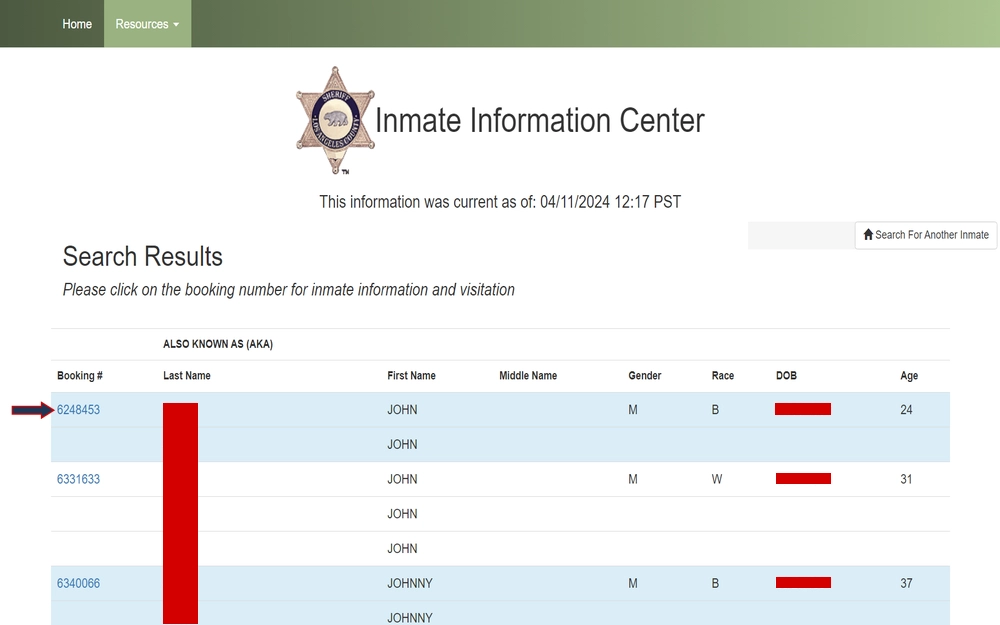
Note that the search will provide a free and publicly available arrest record and information about the detainee, but most video files, audio files, and images, such as mugshots, are not publicly available except under court order or subpoena.
The inmate search returns a list of matching results. Users click on the booking number of the person they are interested in to open up a page of information. The log gives demographic details of the person who was arrested, the date of arrest, the date of processing in the jail, what detention facility the inmates are housed in, and bail information.
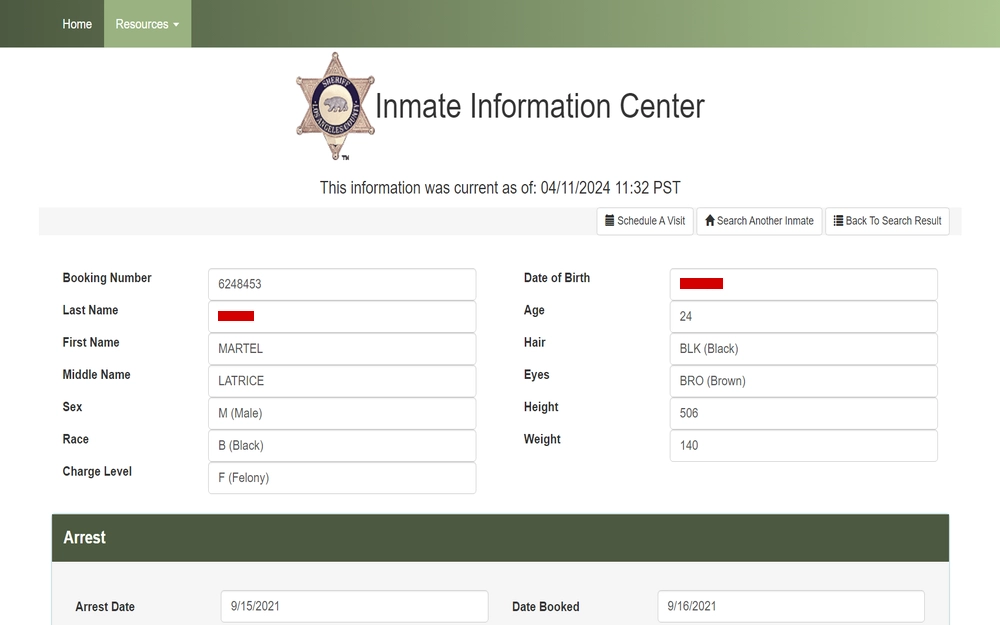
There is also a list of any court dates or cases associated with the arrest. Users can click on the court case details for more information, such as the court name and location if bail was issued, the disposition of the case, and if the judge sentenced the defendant to any jail time or fines.
Interested parties can also contact the jail by phone at the nationwide toll-free number of (800)- 874-1151 or the local number of (213)-473-6100. Alternatively, the booking department may have more information on a recent arrest and can be reached at (213) 893-5327 or by email at [email protected]. You can also go to the jail to inquire about arrests or post bail.
There are nine Los Angeles County detention centers where an inmate may be housed. However, the key contact is the jail’s main offices, where booking and inmate information can be obtained. The main office is located at:
Los Angeles County Jail
Twin Towers Facility
450 Bauchet St.
Los Angeles, CA 90012
Accessing Los Angeles County Arrest Records Through Local Police Departments
Sometimes, interested parties may prefer to inquire about an arrest with the local police agency where the incident occurred. Most cities in Los Angeles County have their own police force and their own jail, where arrestees may be held until transferred to the county jail system.
First, those seeking information about an arrest within the municipality of Los Angeles should understand the dual jurisdiction of law enforcement there. Within municipal limits, there is also a separate Los Angeles Police Department (LAPD).3 The LAPD is a large local law enforcement agency that operates separately from county law enforcement (Los Angeles Sheriff’s Department).
The LAPD operates ten jails that serve as temporary holding centers. Arrestees may be held in city jail while being processed but will be transferred to the County jail system once arraigned.
The LAPD directs interested parties to call 213-473-6100 to ask if someone is in custody. They provide a page with jail and custody information on their website. The contact information for the main office of the LAPD is:
Los Angeles Police Department
180 North Los Angeles Street
Los Angeles, CA 90012
Other large cities also have their own police force and jail as well. For example, the Long Beach Police Department patrols the county’s second-largest city. They make arrests and hold some detainees in their municipal Long Beach Jail temporarily.
Their booking desk is open 24 hours to process prisoner intake, transfer, and release. For information about an arrest and possible detention of someone by the Long Beach PD, searchers should call (562) 570-7260. The police station is located at:
Long Beach Police Department
400 W Broadway
Long Beach, CA 90802
While the County often has the best search tools for inmates, the local agencies are good sources to obtain a police report about an incident. For example, in Long Beach, you can request a police report by mail using the official Application for Release of Report.4 Police reports typically come with an associated fee, such as $23, charged by Long Beach.
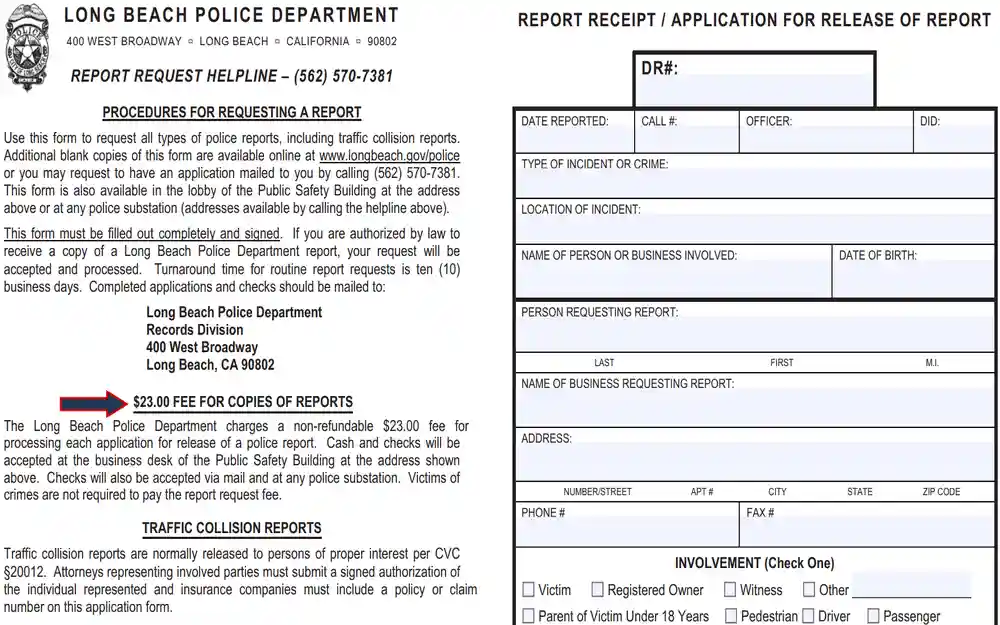
You can mail in the request or hand deliver it to:
Long Beach Police Department
ATTN: INFORMATION MANAGEMENT DIVISION
400 West Broadway
Long Beach, CA 90802
If the county and local methods of research do not help you locate record, you can use third-party operators that compile arrest records.
For example, the service VINELink provides a searchable database of when and where offenders are detained. Though these can be useful as an additional tool, remember that they are not official records and cannot always be relied upon. Make sure to confirm any information with the official channels described in this guide.
These procedures help interested parties discover information about recent arrests and currently jailed detainees. However, sometimes researchers want to search for more detailed criminal records and arrest details through similar agencies.
How To Search Los Angeles County’s Previous Arrest Details & Criminal Charges
There are multiple types of district records related to investigation, arrest, and court appearances related to a suspected crime.
These include the arrest record, record of where an inmate is detained, and any court proceedings where the person is charged with a crime. These are generally available to interested searchers, with the exception of juvenile records, which remain sealed.
Separately, there are also criminal records, which are lists of all arrests, charges, and convictions related to an individual. Criminal records can only be obtained by the person themselves, their lawyer, or law enforcement.
To search previous arrests and criminal charges, start with the previously mentioned Sheriff’s Department Inmate Locator. Just like with current arrests, users can enter a previous inmate’s first and last name and return search results.
If you cannot find the information you need directly through the jail, you can also contact the General Sheriff’s Office at (213) 229-1700 or through an online contact form.
Interested parties can call to schedule an in-person appointment for records assistance. Then, they attend the appointment at the physical address:
Los Angeles County Sheriff’s Department
Hall of Justice
211 W. Temple St.
Los Angeles, California 90012
Some record seekers may want to obtain more than just the online portal result. Inquires and records requests for official copies of arrest and detainment records can be made to the Los Angeles Sheriff’s Department Records & Identification Bureau. Records can be requested by phone, mail, or walk-in during business hours of 8 AM – 5 PM, Monday to Friday, by appointment only.
Fees for records vary from $16 to $45 depending on what information is requested.5 You can pay by cash, credit/debit cards, personal checks, and money orders written to the “Los Angeles County Sheriff’s Department” or “LASD”.
Requesters should provide as much information as possible, including the address or location of the incident, the date of the incident, and the arrestee’s name.
The physical address to attend if you make an appointment is:
Los Angeles County Records & Identification Bureau
Public Services Section
12440 E. Imperial Highway Ste. 120
Norwalk, CA 90650
Requests made by mail should be addressed to:
LASD Records & Identification Bureau
Attn: Records Inquiry Non-Law Enforcement
12440 E. Imperial Highway
Ste. 400 West
Norwalk, CA 90650
Though the Sheriff is the largest source of records, local law enforcement agencies have their own records of arrest that sometimes have more details, such as the full police report.
Consider the large city of Long Beach. The Long Beach Police Department provides a form to request a police report by mail using the official Application for Release of Report. This report costs $23, a fee that varies by city.
You can mail in the request or hand deliver it to:
Long Beach Police Department
ATTN: INFORMATION MANAGEMENT DIVISION
400 West Broadway
Long Beach, CA 90802
Report Helpline: (562) 570-7381
The records desk is open Monday to Friday, 7 am-7 pm and Saturday, 9 am-1 pm (Closed last Saturday of the Month).
To expand to a statewide search for arrest and criminal records, searchers can also use the California Department of Justice’s system. However, access to these “Rap sheets” are limited to certain parties such as police, government agencies, parole and probation officers, jail officers, child welfare workers and other similar organizations.
An individual can access their own criminal record through the Office of the Attorney General. To verify identity, the individual must scan their fingerprints to gain access by using the Live Scan Fingerprint Form.6
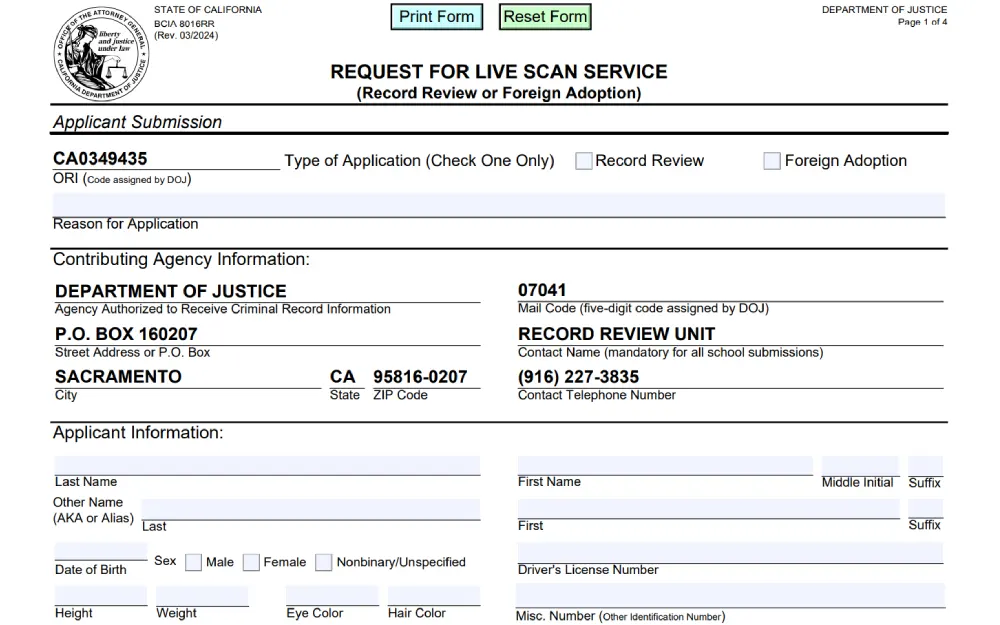
Then the record seeker goes to a live scan site to prove their identity. Fill out an Application to Obtain a Copy of State Summary Criminal History Record.7 Send the application and $25 fee to:
California Department of Justice (DOJ)
Bureau of Criminal Identification & Analysis
Record Review & Challenge Section
PO BOX 160207
Sacramento, CA
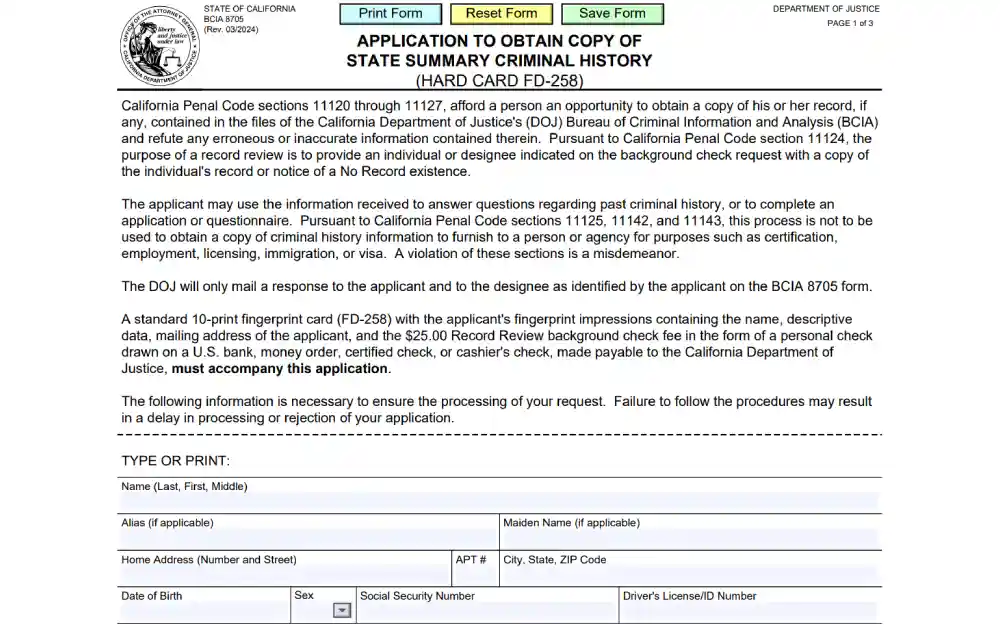
You can use the methods described in this resource to find current and previous arrest records. When a family member or friend is arrested, beyond just finding the record, many interested parties will also want to help by posting bail. Law enforcement also makes the procedure for doing so public as well.
How Do I Post Bail for an Arrest Executed in Los Angeles County?
After being arrested, detainees may be released on their own recognizance or be held pending bail. Bail is money paid to the court and held as a guarantee that the individual will return to court for subsequent hearings or trials.
In many cases, family members or friends may decide to post the full amount of bail in order to secure the detainee’s release. This is often referred to as “self-bail” even though the arrested themselves are not paying. It means that individuals are posting the full amount without the help of a bail bond company.
To post bail in Los Angeles County, first, make sure to locate the detainee using the LASD Inmate Locator to make sure they are held in the County system and to see how much the bail is set for. Then contact the LASD Inmate Reception Center by calling (213) 893-5875 or going in person:
Los Angeles County Sheriff’s Department
Inmate Reception Center
450 Bauchet St.
Los Angeles, CA 90012
The entire amount of bail must be posted. Los Angeles County provides four payment options for self-bail, where a friend or family member can simply pay the full bail themselves at the jail.
Cash, cashier’s check from a bank, Western Union transfers, or a US Postal Service money order. The person posting bail will get the money back at the end of the proceedings for the case unless the person flees and fails to attend hearings or trials
Many people will prefer to secure the help of a bail bonds company. These are licensed companies that provide surety bonds that promise the payment of full bail, which are accepted in lieu of the actual bail.
You will have to pay a non-refundable fee, typically between 5%-10% of the bail, which is kept by the bail bond company as their profit. This service often is used as a way to afford to pay a high bail.
As part of a bail bond agreement, the released individual must attend all court hearings until the case is completed and must pledge collateral that can be seized to pay for the bail in case they flee. If they fail to appear, the bond can be cashed by the court.
The fleeing person is then responsible for the full amount. The bail bonds company can even send bounty hunters to capture a fugitive to return them to the court and force them to pay back the amount of the bond.
Because of these stakes, it is important to fully understand the bail bond contract and to use helpful and reputable bail bond people. A lawyer, court officer, or Sheriff’s Office employee can provide recommendations for bail bonds companies.
Many of the municipal jails also have procedures for bail that are similar to the county. For example, the Los Angeles Police Department (LAPD) provides Jail and Custody Information that can be useful for those who want to bail someone out of the municipal jail.8 Interested parties should begin by calling the police department or city jail.
For the LAPD, callers use 213-473-6100 to verify that the person they wish to bail out is held in the city jail. Note that after being arraigned, most detainees are transferred from city jail to the Sheriff’s Department.
The City of Los Angeles, along with most municipalities, accept the same forms of bail posting, including cash, credit/debit card, Western Union, cashier’s check, or licensed bail bond.
Regardless of the circumstances, when someone is arrested, it is a serious situation where the detainee, friends, and family members seek information about the detention location, charge, and bail.
The sheriff’s office provides free and publicly accessible records of recent and previous Los Angeles County arrest records; this information can assist friends and family with locating and posting bail for a loved one or help keep concerned citizens informed of a suspect’s release.
References
1California Franchise Tax Board. (2023, April 11). California Public Records Act. Retrieved April 11, 2024, from <https://www.ftb.ca.gov/your-rights/california-public-records-act.html>
2Los Angeles County Sheriff’s Department. (2024). Inmate Information Center. Retrieved April 11, 2024, from <https://app5.lasd.org/iic>
3Los Angeles Police Department. (n.d.). Contact Us. Retrieved April 11, 2024, from <https://www.lapdonline.org/contact-us/>
4Long Beach Police Department. (2018, November). Report Receipt / Application for Release of Report. Retrieved April 11, 2024, from <https://longbeach.gov/globalassets/police/media-library/documents/how-do-i/request-a-police-report/2019-report-receipt-form>
5Los Angeles County Sheriff’s Department. (2022, June 30). Service Fees – General Public. Retrieved April 11, 2024, from <https://lasd.org/wp-content/uploads/2022/07/RIB_Fees_for_Reports_and_Services_063022.pdf>
6California Department of Justice. (2024, March). Request for Live Scan Service. Retrieved April 11, 2024, from <https://oag.ca.gov/system/files/media/BCIA-8016RR.pdf>
7California Department of Justice. (2024, March). Application To Obtain Copy of State Summary Criminal History. Retrieved April 11, 2024, from <https://oag.ca.gov/system/files/media/BCIA-8705.pdf>
8Los Angeles Police Department. (n.d.). Jail and Custody Information. Retrieved April 11, 2024, from <https://www.lapdonline.org/office-of-the-chief-of-police/administrative-services-bureau/custody-services-division/jail-and-custody-information/>
